7 Most Spectacular Underground Rivers in the World
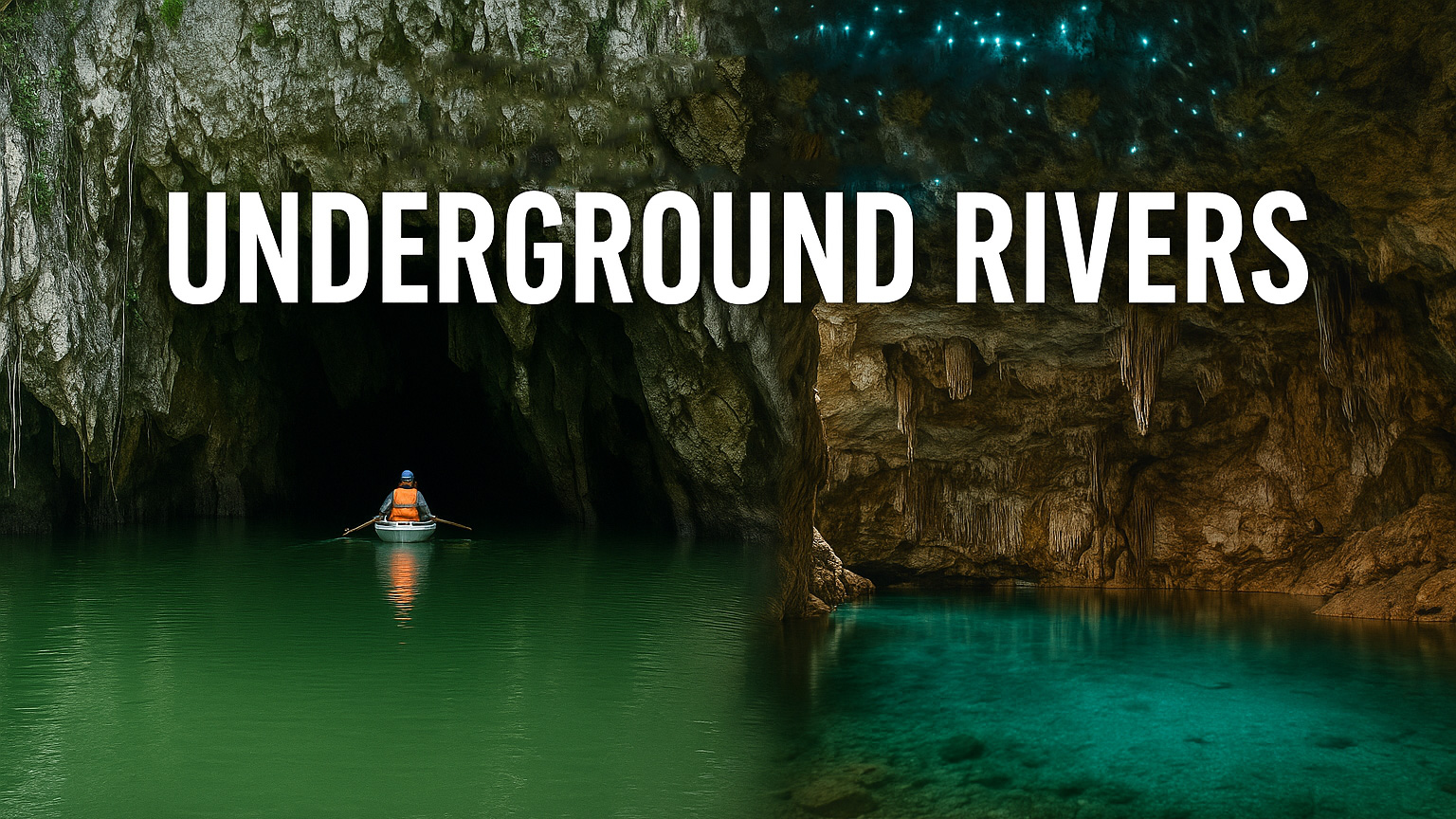
Discover 7 breathtaking underground rivers across the globe — from Palawan to Mexico — hidden waterways flowing through caves and karst landscapes.
Beneath mountains and forests, where daylight fades and silence takes over, entire rivers slip into the earth and carve secret passages through stone. These underground rivers are some of nature’s most mysterious creations — winding through limestone caverns, echoing with the drip of stalactites, and often carrying legends as deep as their waters.
From the Asia to South America, these hidden waterways are not only geological wonders but also unforgettable travel destinations. Whether explored by boat, on foot, or by diving into cenotes and cave pools, they reveal a hidden world few ever get to see.
How Do Underground Rivers Form?
Underground rivers are born in landscapes shaped by karst geology, where soluble rocks such as limestone, dolomite, or gypsum are slowly eaten away by water. Rainfall, slightly acidic from dissolved carbon dioxide, seeps into cracks and crevices. Over thousands, sometimes millions of years, this process enlarges the fractures into tunnels, caverns, and entire subterranean networks.
When surface rivers or rainfall find their way into these openings, they vanish into the earth, flowing silently beneath forests and mountains. Some travel only a short distance before re-emerging in a spring, while others wind through the darkness for dozens of kilometers. Some rivers emerge in the form of a beautiful circular lake.
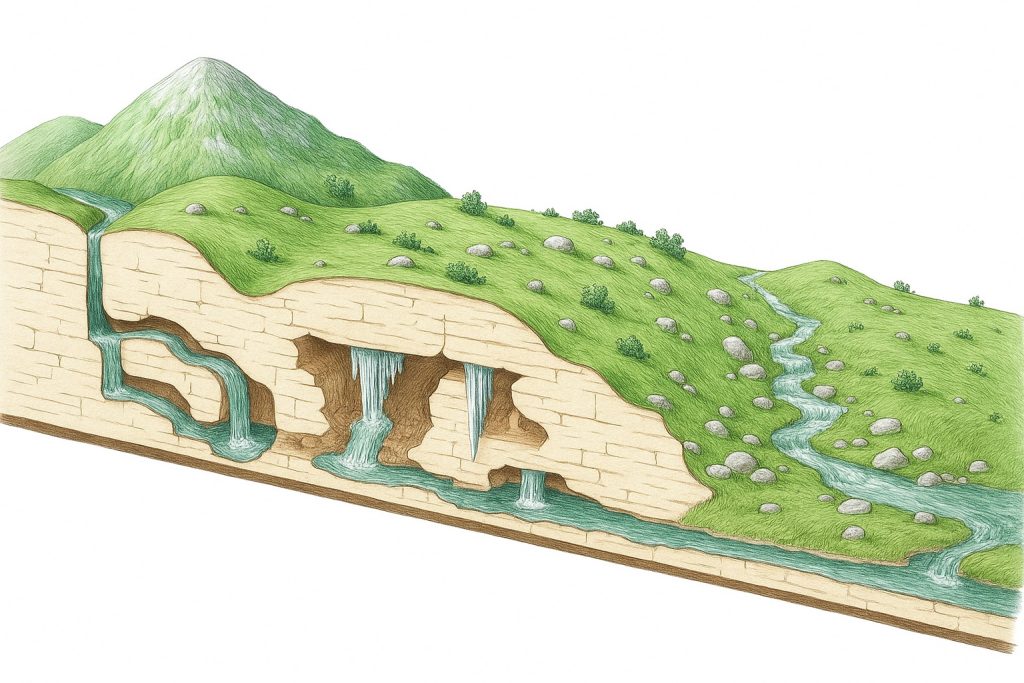
Key stages of formation:
- Dissolution: Acidic water dissolves soluble rock, carving voids underground.
- Cave Development: These voids grow into chambers and passageways.
- River Capture: Surface streams or rainfall funnel underground, taking the newly formed routes.
- Resurgence: The hidden river eventually reappears at the surface, often at a karst spring.
The result is a world of sinkholes, cenotes, caves, and subterranean waterways — a secret realm where rivers write their own hidden histories beneath our feet.
Where Are Underground Rivers Found?
Underground rivers are most prevalent in regions shaped by karst landscapes, where soluble rocks — primarily limestone, but also dolomite and gypsum — have been sculpted by water over millions of years. These areas are riddled with sinkholes, caves, and springs, making them the perfect setting for rivers to vanish and reappear.
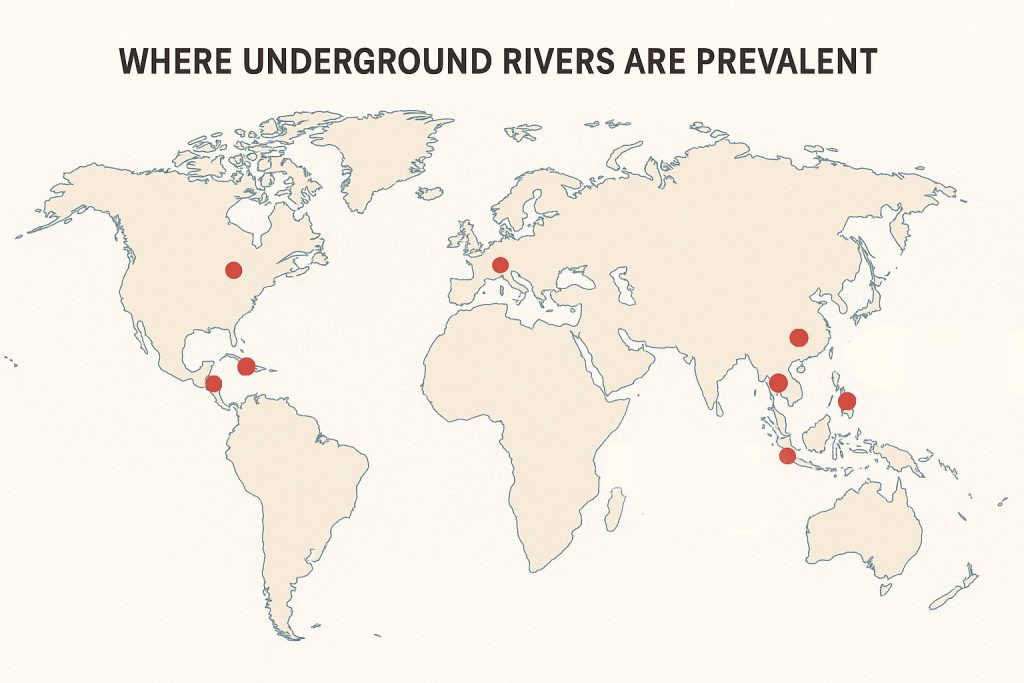
Some of the world’s richest underground river systems occur in:
- The Dinaric Karst (Balkans, incl. Croatia, Slovenia, Bosnia & Herzegovina):
One of the largest continuous karst regions in the world. Rivers like the Reka dive underground, carving UNESCO-listed cave systems such as Škocjan. - Southeast Asia (Philippines, Vietnam, Laos, Thailand):
Towering limestone mountains (karst towers) hide immense subterranean waterways, including Puerto Princesa in Palawan and the underground rivers of Phong Nha–Ke Bang in Vietnam. - Mesoamerica (Mexico & Central America):
The Yucatán Peninsula is honeycombed with cenotes and flooded caves, forming vast underground river systems like Sac Actun. - Southern China (Guangxi & Yunnan):
The famous karst towers of Guilin and Fengshan conceal labyrinthine subterranean rivers. - Mediterranean Karst Regions (Spain, Italy, Turkey):
Smaller, yet spectacular, underground river caves abound in these ancient limestone belts. - Caribbean (Puerto Rico, Cuba, Dominican Republic):
The tropics’ humid climate accelerates limestone dissolution, producing rivers like the Camuy.
Why limestone?
Because limestone dissolves relatively easily in slightly acidic water, it creates the caves, conduits, and voids that rivers need to flow underground. Other rock types (granite, basalt) don’t usually allow such systems to form.
The Most Famous Underground Caves
1. Puerto Princesa Underground River, Palawan, Philippines
Tucked away on the island of Palawan, the Puerto Princesa Underground River is one of the most celebrated underground rivers in the world — and proudly listed as one of the New 7 Wonders of Nature.
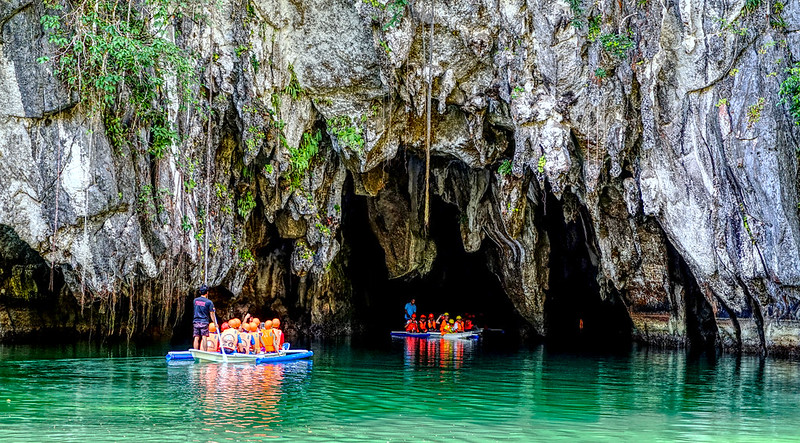
- A Natural Marvel: Stretching for 8.2 kilometers beneath limestone cliffs, this underground river winds through colossal caverns filled with stalactites, stalagmites, and rock formations that resemble cathedrals carved by time.
- A Journey to the Sea: The river’s mouth opens just a few meters from the sea, making it one of the rare underground waterways that flows directly into the ocean. The transition from the calm, dark cave waters to the turquoise South China Sea is mesmerizing.
- Wildlife Haven: Beyond the geology, the cave is alive with colonies of bats, swiftlets, and other cave-adapted creatures. Outside, Palawan’s pristine forests shelter monkeys, monitor lizards, and hornbills.
- Traveler’s Experience: Guided paddle-boat tours allow visitors to glide silently into the cavernous interior. With only the boatman’s headlamp illuminating the darkness, each twist of the river reveals hidden chambers and walls that rise up like a gothic cathedral. The stillness is broken only by the sound of dripping water and the flutter of wings.
✨ Visiting Puerto Princesa feels like descending into another realm — one where the boundary between river, cave, and sea dissolves into a single wonder.
2. Reka River – Škocjan Caves, Slovenia
In the heart of the Dinaric Karst, the Reka River performs a dramatic disappearing act: plunging into the vast gorges of the Škocjan Caves, a UNESCO World Heritage Site.

- Europe’s Underground Canyon: Inside, the river roars through a cavern so immense it rivals the Grand Canyon — but hidden beneath the earth.
- A Living Karst System: Bridges span over the turbulent waters, allowing visitors to walk high above the underground torrent.
- Historic Wonder: These caves have been known since prehistoric times, with legends and myths entwined with their depths.
✨ To stand inside Škocjan is to feel the power of water reshaping stone — a raw encounter with geology in motion.
3. Sac Actun System, Mexico
Beneath the lush jungles of the Yucatán Peninsula lies the Sac Actun system — the world’s longest mapped underground river and cave network, stretching more than 300 km.
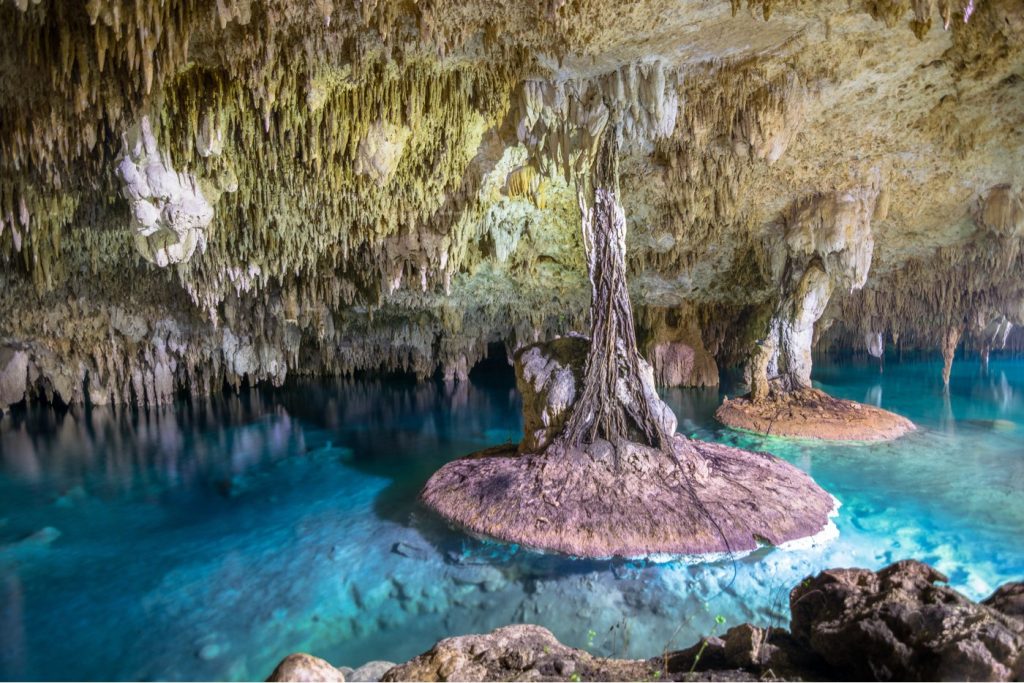
- Sacred Waters of the Maya: Cenotes, or sinkholes, serve as entrances, once believed to be gateways to the underworld (Xibalba).
- Crystal Worlds: Divers find themselves in a labyrinth of tunnels, where stalactites hang like chandeliers above glass-clear pools.
- Biodiversity Below: Blind cave fish, shrimp, and unique microorganisms thrive in these dark waters.
✨ Diving into Sac Actun feels like slipping between worlds — one foot in history, one in myth, and one in an endless blue silence.
4. Waitomo Glowworm Caves, New Zealand
In New Zealand’s North Island, the Waitomo Caves offer an underground river journey unlike any other — one lit by living stars.
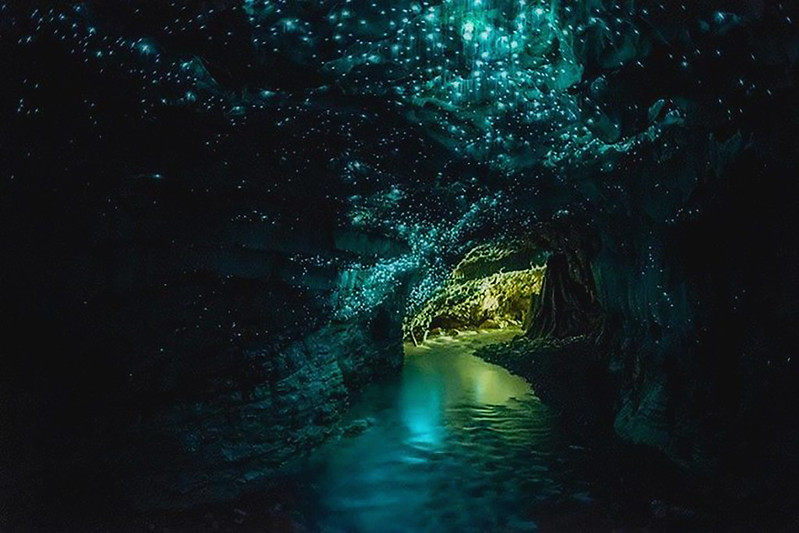
- Glowworm Constellations: Thousands of glowworms cling to the ceilings, their bioluminescent threads casting a green-blue light across the darkness.
- Gentle Boat Tours: Visitors drift silently along the underground river as if sailing beneath a starlit sky.
- A Fragile Beauty: The ecosystem is delicate, with the glowworms’ light depending on a careful balance of humidity and air.
✨ Waitomo feels like nature’s planetarium — a reminder that even the smallest creatures can create the most magical spectacles.
5. Son Doong Cave, Vietnam
Hidden in Vietnam’s Phong Nha–Ke Bang National Park, Son Doong is the world’s largest cave — so vast it has its own underground river, jungle, and weather system.
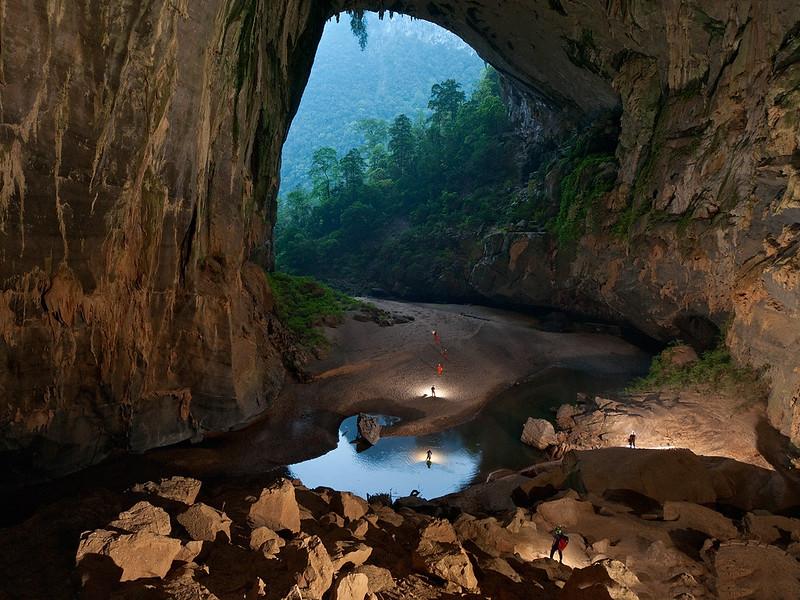
- Colossal Dimensions: The cave is large enough to fit a 40-story skyscraper inside.
- A Flowing Heart: Its underground river cuts through giant halls, sometimes plunging into pools before vanishing again.
- Adventure of a Lifetime: Expeditions involve multi-day treks, river crossings, and camping inside the cave.
✨ Son Doong is not just a cave with an underground river — it’s an entire hidden world, alive with mystery and scale beyond imagination.
6. Camuy River Cave Park, Puerto Rico
In Puerto Rico, the Camuy River has carved out more than 200 caves and sinkholes, creating the third-largest underground river system in the world.
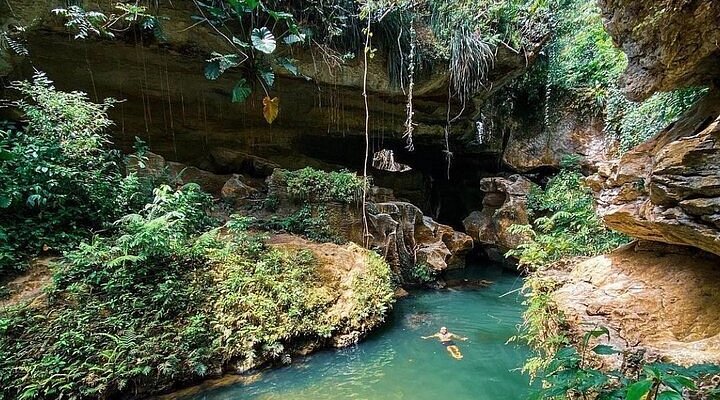
- A Subterranean Labyrinth: The Camuy flows through an immense karst valley, its path marked by colossal caverns and natural bridges.
- Visitor-Friendly: Camuy Cave Park offers boardwalks and tours, making this natural wonder accessible to many travelers.
- Hidden Falls: In some chambers, waterfalls tumble into the darkness, echoing like thunder.
✨ Exploring Camuy feels like wandering through the Earth’s veins — a reminder of how water shapes life above and below ground.
7. Fengshan Karst, China
China’s Guangxi region is famous for its limestone towers, but beneath them lies the Fengshan Karst, riddled with secret rivers.

- Labyrinth of Water: Rivers run for dozens of kilometers beneath mountains, linking sinkholes and hidden springs.
- Less Explored: Unlike Palawan or Waitomo, many of these systems remain remote and little-visited, attracting speleologists more than tourists.
- A Landscape of Legends: Local folklore often ties these hidden rivers to dragons and spirits, echoing the mystery of the land.
✨ Fengshan is a quieter wonder — not a tourist attraction, but a place where underground rivers still guard their secrets.
Conclusion
Underground rivers remind us that not all rivers run under the open sky. Some vanish into the earth, re-emerging only after long journeys through stone. Visiting them feels like stepping into another realm — one where geology, mystery, and mythology flow together.



